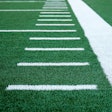Cleanliness is not only important for keeping your facility looking and smelling good, but also for keeping the men and women users healthy.
From locker rooms to treadmills and everywhere in between, keeping a fitness center clean - be it military, municipal or school - is difficult. Cleanliness is not only important for keeping your facility looking and smelling good, but also for keeping users healthy. Unfortunately, members will come in with muddy shoes, dirty hands and, although not pleasant to think about, they're bound to pick their noses and fail to wash their hands after using the bathroom. In fact, just five percent of people properly wash their hands after using the bathroom, according to a new study from Michigan State University
While it is a top priority to keep facilities as germ-free as possible, it is not an easy task. Usually patrons and staff members will clean the most visible of areas such as treadmill handrails, bike seats and bench pads. But, while those spots may check out as clean, germs that pose threats of everything from the common cold to MRSA and staph infections - even ringworm - may be lurking right under fitness center staff members' noses.
"From a gym management standpoint, it's important to make sure you are thoroughly cleaning and killing germs, not just making your facility look clean," says Sean Kajcienski, chief sales officer for Coverall Health-Based Cleaning System. "Great germ killing requires military-like consistency and cleaning protocols. People typically think something is clean because it looks and smells clean. It's what you can't see that is dangerous. The health of every fitness facility depends on it."
Dr. Scott Weiss, a board-certified athletic trainer and licensed physical therapist agrees that it takes more than just eyeballing the gym or doing a white-glove test to check the real cleanliness of the fitness center.
"Military fitness centers, just like any other, need to be aware of germs as they can keep the military athletes down with a wide-range of issues," says Weiss. "A fitness center can look clean and smell clean but not really be clean, and you can't tell just by looking as you walk through the facility."
Weiss says he uses a germ meter to ensure the cleanliness of his tools and facility, using standards picked up from time working with the United States Olympic Committee and its athletes as part of its sports medical team.
Coverall has also utilized testing to find out the true cleanliness of facilities and other items.
A device called the adenosine triphosphate meter detects biological contaminants. Commonly used by food industry inspectors, it's great for measuring degrees of contamination in fitness centers and gyms, says Kajcienski. "Anything over a level of 100 is considered dangerous; Coverall has measured cell phones and other public high-touch surfaces with levels exceeding 4,000."
The broad offerings found in a fitness facility only multiply the risk and the number of places staff members need to keep clean.
A recent study by University of California, Irvine researchers demonstrated that basketballs and volleyballs can spread potentially dangerous germs among players and staff that handle the balls.
"The overwhelming prevalence of staph aureus we encountered supports our understanding of the gym environment as a reservoir of germs," says Joshua A. Cotter, a postdoctoral fellow in orthopedic surgery who helped supervise the study. "Institutions, coaches and athletes should take note of the role the sports ball can play as a vehicle for the transmission of potentially life-threatening germs."
But even on the fitness floor, germs are probably lurking in places that rarely, if ever, get cleaned and sanitized.
"With so many people now using some of the newer functional equipment there are even more places to pick-up germs, many of which aren't cleaned as frequently as machines and other equipment," says Weiss. "Things like stability balls and foam rollers that everyone is using carry so much bacteria and they hardly ever get cleaned."
A fitness center can use all the best, hospital-grade cleaners and leave sanitizer dispensers around the club, but without vigilant work from management and staff members, those products can go to waste.
"Military discipline is ideal for the rigor, discipline and procedures needed for proper cleaning," says Kajcienski. "Use the right tools, clean constantly and consistently, properly launder microfiber to kill the germs they carry."
Weiss adds that motivating the military fitness center's staff takes a bit of training and a touch of reason.
"All you need to do is let them know that they spend more time there than anyone and that if they don't clean their "house" they are going to bring anything going around home," he says.
Four ways to keep the fitness center up to military standards:
1. Utilize hospital-grade cleaners containing 10 percent bleach or a full-spectrum cleaner.
2. Use high-filtration vacuums (which remove dead germs and dirt) and microfiber cloths (which remove 99 percent of dirt and germs).
3. Make sure cleaning staff is briefed on hotspots - including door handles to facilities, jumprope handles, stability balls and stretching mats.
4. Make hand sanitizers accessible, but also promote the proper techniques to wash hands.
Interested in more military-specific content? Sign up for AB Military News, our weekly newsletter with content specifically for military sports, recreation and fitness professionals.




































